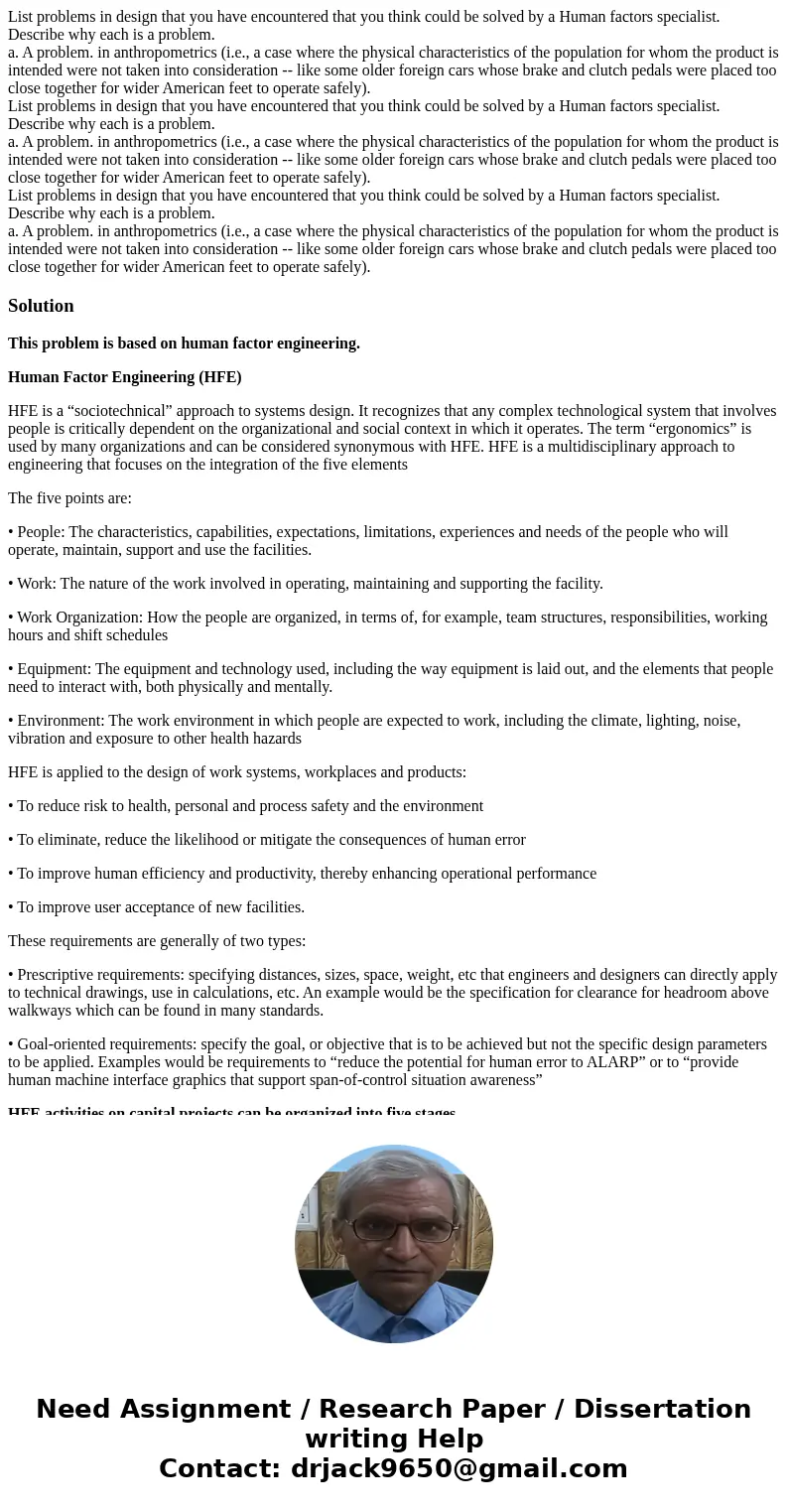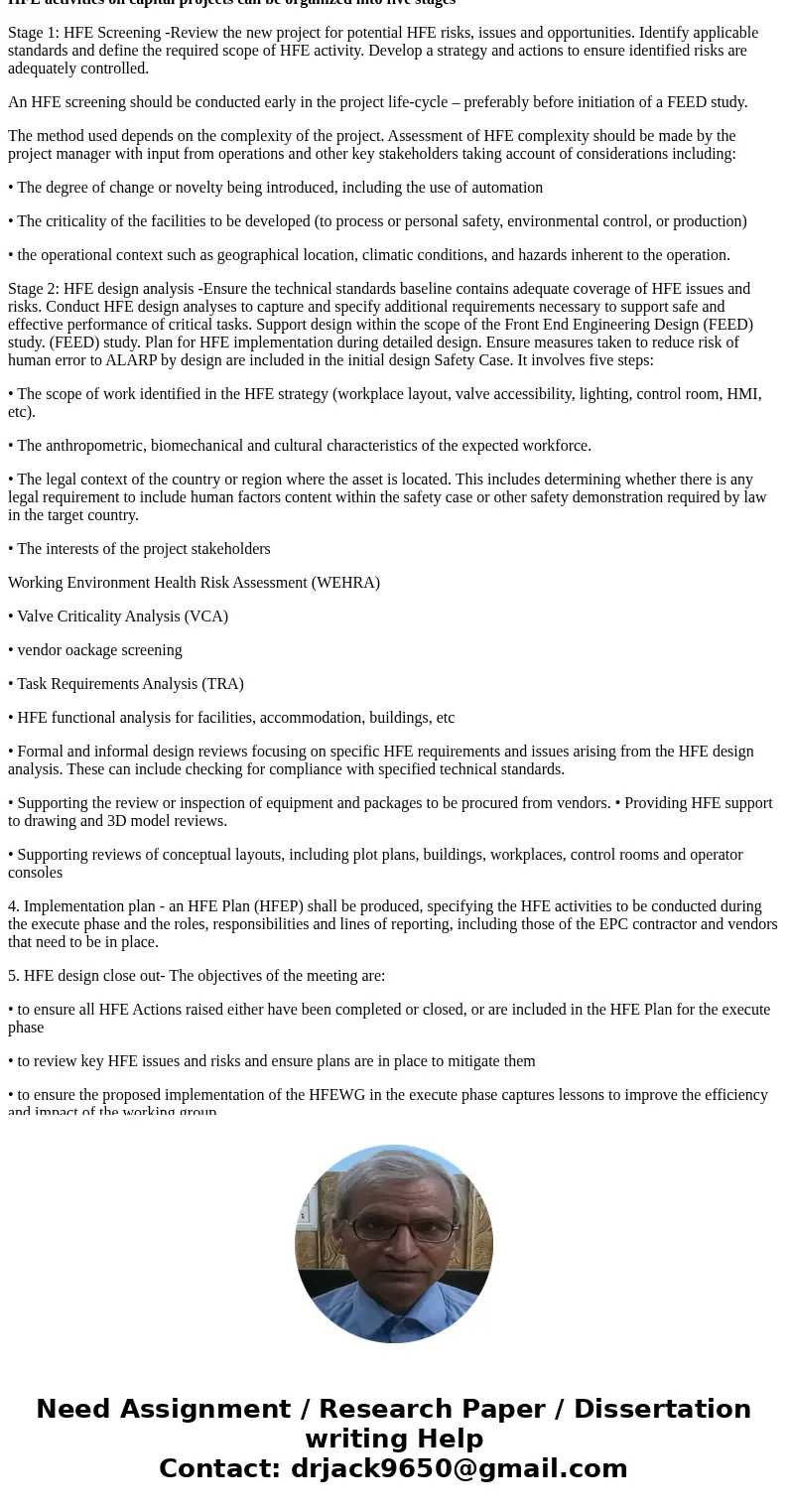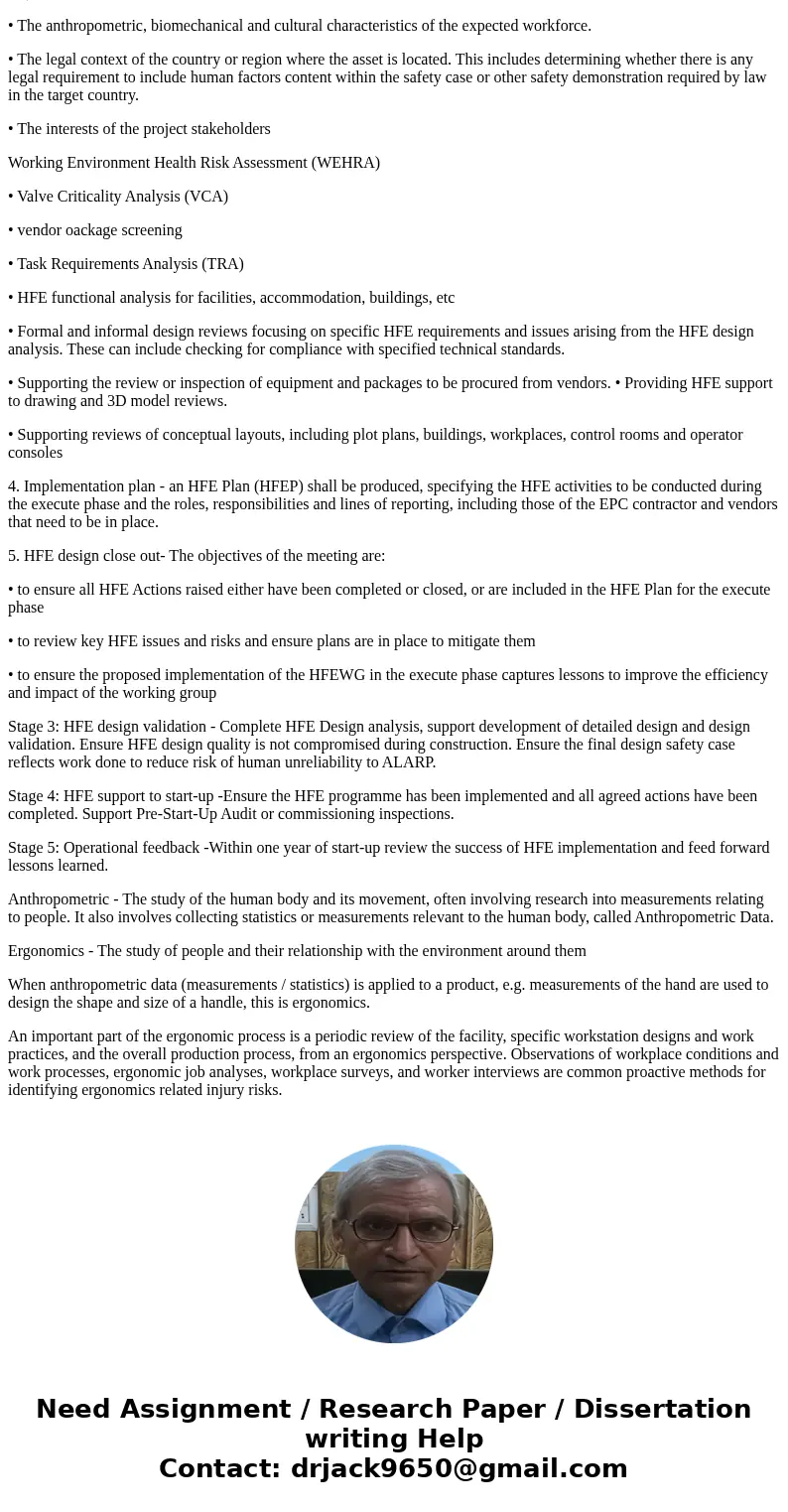List problems in design that you have encountered that you t
Solution
This problem is based on human factor engineering.
Human Factor Engineering (HFE)
HFE is a “sociotechnical” approach to systems design. It recognizes that any complex technological system that involves people is critically dependent on the organizational and social context in which it operates. The term “ergonomics” is used by many organizations and can be considered synonymous with HFE. HFE is a multidisciplinary approach to engineering that focuses on the integration of the five elements
The five points are:
• People: The characteristics, capabilities, expectations, limitations, experiences and needs of the people who will operate, maintain, support and use the facilities.
• Work: The nature of the work involved in operating, maintaining and supporting the facility.
• Work Organization: How the people are organized, in terms of, for example, team structures, responsibilities, working hours and shift schedules
• Equipment: The equipment and technology used, including the way equipment is laid out, and the elements that people need to interact with, both physically and mentally.
• Environment: The work environment in which people are expected to work, including the climate, lighting, noise, vibration and exposure to other health hazards
HFE is applied to the design of work systems, workplaces and products:
• To reduce risk to health, personal and process safety and the environment
• To eliminate, reduce the likelihood or mitigate the consequences of human error
• To improve human efficiency and productivity, thereby enhancing operational performance
• To improve user acceptance of new facilities.
These requirements are generally of two types:
• Prescriptive requirements: specifying distances, sizes, space, weight, etc that engineers and designers can directly apply to technical drawings, use in calculations, etc. An example would be the specification for clearance for headroom above walkways which can be found in many standards.
• Goal-oriented requirements: specify the goal, or objective that is to be achieved but not the specific design parameters to be applied. Examples would be requirements to “reduce the potential for human error to ALARP” or to “provide human machine interface graphics that support span-of-control situation awareness”
HFE activities on capital projects can be organized into five stages
Stage 1: HFE Screening -Review the new project for potential HFE risks, issues and opportunities. Identify applicable standards and define the required scope of HFE activity. Develop a strategy and actions to ensure identified risks are adequately controlled.
An HFE screening should be conducted early in the project life-cycle – preferably before initiation of a FEED study.
The method used depends on the complexity of the project. Assessment of HFE complexity should be made by the project manager with input from operations and other key stakeholders taking account of considerations including:
• The degree of change or novelty being introduced, including the use of automation
• The criticality of the facilities to be developed (to process or personal safety, environmental control, or production)
• the operational context such as geographical location, climatic conditions, and hazards inherent to the operation.
Stage 2: HFE design analysis -Ensure the technical standards baseline contains adequate coverage of HFE issues and risks. Conduct HFE design analyses to capture and specify additional requirements necessary to support safe and effective performance of critical tasks. Support design within the scope of the Front End Engineering Design (FEED) study. (FEED) study. Plan for HFE implementation during detailed design. Ensure measures taken to reduce risk of human error to ALARP by design are included in the initial design Safety Case. It involves five steps:
• The scope of work identified in the HFE strategy (workplace layout, valve accessibility, lighting, control room, HMI, etc).
• The anthropometric, biomechanical and cultural characteristics of the expected workforce.
• The legal context of the country or region where the asset is located. This includes determining whether there is any legal requirement to include human factors content within the safety case or other safety demonstration required by law in the target country.
• The interests of the project stakeholders
Working Environment Health Risk Assessment (WEHRA)
• Valve Criticality Analysis (VCA)
• vendor oackage screening
• Task Requirements Analysis (TRA)
• HFE functional analysis for facilities, accommodation, buildings, etc
• Formal and informal design reviews focusing on specific HFE requirements and issues arising from the HFE design analysis. These can include checking for compliance with specified technical standards.
• Supporting the review or inspection of equipment and packages to be procured from vendors. • Providing HFE support to drawing and 3D model reviews.
• Supporting reviews of conceptual layouts, including plot plans, buildings, workplaces, control rooms and operator consoles
4. Implementation plan - an HFE Plan (HFEP) shall be produced, specifying the HFE activities to be conducted during the execute phase and the roles, responsibilities and lines of reporting, including those of the EPC contractor and vendors that need to be in place.
5. HFE design close out- The objectives of the meeting are:
• to ensure all HFE Actions raised either have been completed or closed, or are included in the HFE Plan for the execute phase
• to review key HFE issues and risks and ensure plans are in place to mitigate them
• to ensure the proposed implementation of the HFEWG in the execute phase captures lessons to improve the efficiency and impact of the working group
Stage 3: HFE design validation - Complete HFE Design analysis, support development of detailed design and design validation. Ensure HFE design quality is not compromised during construction. Ensure the final design safety case reflects work done to reduce risk of human unreliability to ALARP.
Stage 4: HFE support to start-up -Ensure the HFE programme has been implemented and all agreed actions have been completed. Support Pre-Start-Up Audit or commissioning inspections.
Stage 5: Operational feedback -Within one year of start-up review the success of HFE implementation and feed forward lessons learned.
Anthropometric - The study of the human body and its movement, often involving research into measurements relating to people. It also involves collecting statistics or measurements relevant to the human body, called Anthropometric Data.
Ergonomics - The study of people and their relationship with the environment around them
When anthropometric data (measurements / statistics) is applied to a product, e.g. measurements of the hand are used to design the shape and size of a handle, this is ergonomics.
An important part of the ergonomic process is a periodic review of the facility, specific workstation designs and work practices, and the overall production process, from an ergonomics perspective. Observations of workplace conditions and work processes, ergonomic job analyses, workplace surveys, and worker interviews are common proactive methods for identifying ergonomics related injury risks.



 Homework Sourse
Homework Sourse